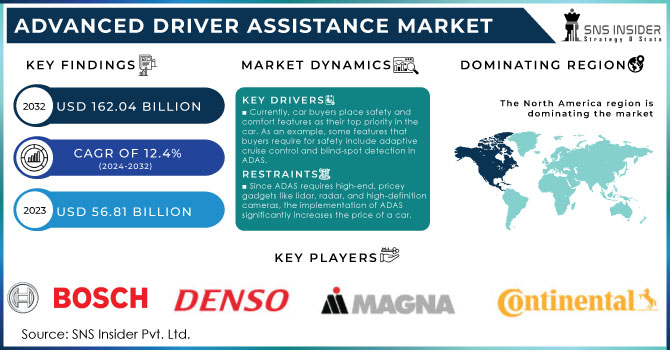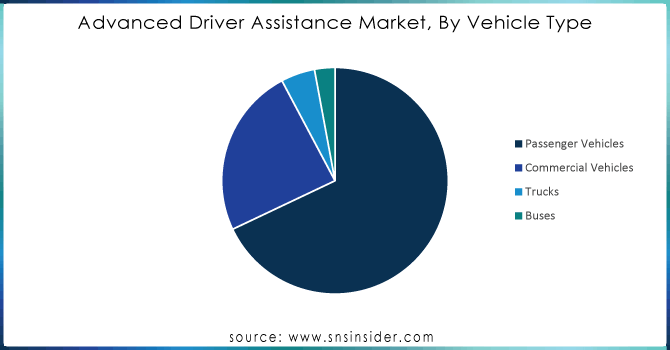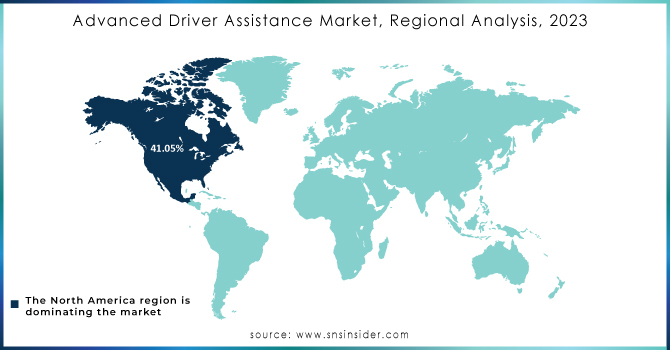Advanced Driver Assistance Market Report Scope & Overview:

Get More Information on Advanced Driver Assistance Market - Request Sample Report
The Advanced Driver Assistance Market size is projected to reach USD 162.04 billion by 2032, was values at USD 56.81 billion in 2023 and will grow at a CAGR of 12.4% over 2024-2032.
The demand for such systems on the consumer front has been consistently rising, and from what the current adoption rate portrays, the ADAS market is prepared to achieve high growth. A 2023 survey by the American Automobile Association showed that 72% of United States drivers would pay extra for advanced safety features such as Automatic Emergency Braking. Also, it coincides with the government's policies aimed at increasing ADAS usage. The NHTSA proposes mandating all new light-duty vehicles with AEB systems by 2026 after which the use of ADAS will be increased by leaps and bounds. Besides, the segment of luxury cars in the US will sell up to 2.8 million units by the year 2025, indicating that it is also among the main drivers for the development of ADAS. Also, these types of cars are usually equipped with lots of advanced driver-assistance features, which makes market growth even much better. Such development would mean that for the next few years, the US ADAS sector is bound to grow hugely on account of greater emphasis on safety by better regulation and a strong luxury car segment.
According to a recent Insurance Institute for Highway Safety study, LDW systems can cut the odds of lane departure collisions by 86%, showing how effective this technology is. The second reason is that more stringent government regulations have required the installation of some features of ADAS in cars. All new passenger cars and light trucks sold in the US from May 2022 shall come fitted with AEB as standard, thus making the way for wider adoption. Thirdly, the development of sensor technology in particular-LiDAR-developing more sophisticated ADAS functions is now conceivable. With 20% LiDAR penetration expected in US luxury cars by 2025, high-resolution 3D perception will allow enhanced object recognition and auto lane changing, among others.
Advanced Driver Assistance Market Dynamics:
-
An important factor is the fact that accidents are very prevalent throughout the world, coming about because of human error. This can be addressed directly by functions such as collision warning and lane departure warning, which allow immediate feedback and corrective measures in ADAS functionalities.
-
More states are requiring the installation of ADAS systems in new cars. Moreover, these efforts also advocate progress in general; for instance, the "Vision Zero" campaign from the European Union set a target for zero road deaths until 2050.
-
Currently, car buyers place safety and comfort features as their top priority in the car. As an example, some features that buyers require for safety include adaptive cruise control and blind-spot detection in ADAS.
This imperative shift starts with technological guardian angels, namely Advanced Driver-Assistance Systems, on our roads. Take Adaptive Cruise Control, for example; it takes away the monotony of highway commuting because it responsively manages a secure offering from the vehicle ahead. Blind-Spot Detection acts as extra eyes for the consumer that identify blind corners where there might be vehicles crossing over lanes or changing lanes without even knowing it. It goes deeper than any one particular feature; it becomes general awareness. Studies are indicating that well over eighty percent of drivers report having ADAS on their cars and has increased confidence and made them feel more in control on the road. This is a harbinger of smooth drives for one and all on the road. This demand for features is not just hearsay.
Restrains:
-
Since ADAS requires high-end, pricey gadgets like lidar, radar, and high-definition cameras, the implementation of ADAS significantly increases the price of a car.
-
Being complex, software-based systems, ADAS systems are also prone to hacking. A cyber-attack on an ADAS is most likely to hijack the vehicle, resulting in losses of life and property.
Successful cyberattacks on ADAS systems will have consequences that may not be confined to single incidents of compromise; it could mean a halt in their development and deployment due to the erosion of consumer confidence in this technology. Additionally, such incidents may result in choking regulations because widescale traffic accidents and fatalities would probably impede innovation-no longer allowing the complete realization of the ADAS potentiality. That calls for strong cybersecurity measures towards safe integration of ADAS into any vehicle models." This involves unceasing watchfulness against changing hacking threats, following secure coding practices, and carrying out thorough penetration testing to find out and fix vulnerabilities before they are exploited.
Advanced Driver Assistance Market Market Segment Overview
By Vehicle Type
The Passenger Vehicles category held the highest share of 75% in 2023. This is explained by several things. Initially, there has been rising awareness as well as government regulations that make the consumers in developing markets increasingly give priority to safety features in their personal cars. Furthermore, technological advances have made it affordable for use outside luxury car segments. In 2023, vans and pickups, classified as Light Commercial Vehicles (LCVs), accounted for 15% of share. Urbanization growth and increasing delivery requirements has resulted to this rise due to commercial value of ADAS. Trucks and Buses are grouped together in accounting for the remaining 10%. There are obvious benefits of applying this technology on these bigger vehicles however, factors like higher initial costs involved and complex integration into existing infrastructure have hampered its adoption rate.

Need any customization research on Advanced Driver Assistance Market - Enquiry Now
By Electric Vehicle Type
BEVs accounted for 40% of share in 2023 and is considered as the most popular among ADAS market. On the contrary, Fuel Cell Electric Vehicles received the lowest share due to their limited production volumes and emphasis on immediate safety improvements rather than overall car range. Their part is projected to be just below 5%. Hybrid Electric Vehicles (HEVs) fall somewhere in between and make up about 30%. The desire to have environmentally friendly cars that still use internal combustion engines makes them more attractive to wider consumer base where ADAS features may be perceived as additional benefits rather than necessities. Plug-in Hybrid Electric Vehicles (PHEVs) are an interesting case they can operate both on electricity and petrol making this segment lie between BEVs and HEVs. SNS Insider analysts see their proportion in ADAS being at around 25%, which reflects a trade-off between BEVs’ safety orientation vs HEVs broader appeal.
By Level of Autonomy
The largest proportion of the market, constituting about 70% in 2023, is for L1 which has basic features like Automatic Emergency Braking (AEB) and Lane Departure Warning (LDW). This dominance is due to their affordability, extensive availability as well as their function as a bridge towards autonomous driving. About 20% of the market falls into L2 which includes Adaptive Cruise Control (ACC) and Lane Keeping Assist (LKA). In this segment, there is a sense of automation but it still requires the presence of a driver all through driving. Conditional Automation or L3 accounts for approximately 5% of the market. In such cases, certain tasks can be performed by the vehicle in specific conditions although readiness on part of driver to take over remains crucial.
High Automation or L4 represents a significant leap but only makes up about 3% of the total market share. These types of cars can run without drivers, subject to certain limitations, such as unusual situations that may necessitate their intervention.
Advanced Driver Assistance Market Regional Analysis:
North America is the leader in the ADAS market accounted for 41.05% global share in 2023, due to several factors. Tt is evident that there is a high demand for safety features in vehicles since more than 60% of US car buyers prioritize ADAS functionalities such as Automatic emergency braking and Lane departure warning. Second, government regulations in the region are also forcing the incorporation of core ADAS functions thereby pushing up market numbers even further. An example here is NHTSA’s call for automatic emergency braking systems in light-duty vehicles by 2023. Thirdly, North America benefits from the presence of major automotive OEMs (Original Equipment Manufacturers) and a strong tier-one supplier base which creates a vibrant environment for ADAS research and implementation. That is why over 40% of cars manufactured in Detroit are equipped with level 2 intelligent driving capabilities; this marks an important milestone toward partial automation. However, challenges will be issue of privacy concerns and possible cyber-attacks on these systems persists, requiring manufacturers to come up with robust solutions.
Europe will be growing at a highest CAGR of 13.4% over 2024-2032, due to several key reasons. Strict safety regulations from the European Union (EU) require the progressive introduction of ADAS features like Lane Departure Warning (LDW) and Autonomous Emergency Braking (AEB) in new cars thereby fostering their integration by manufacturers. In that regard IHS Markit expects Europe’s LDW penetration ratio to reach 82% by 2025, contrasted with the global average of 67%. Secondly, a growing emphasis on easing traffic jams and safeguarding pedestrians within crowded regions in Europe has hastened adoption of ADAS techniques. According to ACEA researches, pedestrian and cyclist accident rates can drop by up to 30% with vehicles having AEB technology.

Key Players:
The major key players are Robert Bosch, ZF Friedrishshafen, Continental AG, Denso, Magna International, Mobiliye, Valeo, Hyundia Mobis, Aptiv and others.
Recent Developments:
-
In February 2024, Bosch released a statement concerning its partnership with Microsoft to explore generative AI for vehicle features that could possibly revolutionize automation.
-
Continental’s focus on advanced technology is consistent with this. In February, they launched an 8MP high-resolution camera boasting a 30% improvement on earlier versions. This translates into better details for features like autonomous driving and 3D surround view, enhancing safety and parking assistance.
-
ZF Friedrichshafen, a Tier-One supplier, is not sitting idle either. They designed their Smart Camera 6 specifically for advanced driver-assistance systems in January 2023. This barrage of hi-tech cameras may mark a tipping point towards better visual perception in ADAS.
| Report Attributes | Details |
|---|---|
| Market Size in 2023 | US$ 56.81 Billion |
| Market Size by 2032 | US$ 162.04 Billion |
| CAGR | CAGR of 12.4 % From 2024 to 2032 |
| Base Year | 2023 |
| Forecast Period | 2024-2032 |
| Historical Data | 2020-2022 |
| Report Scope & Coverage | Market Size, Segments Analysis, Competitive Landscape, Regional Analysis, DROC & SWOT Analysis, Forecast Outlook |
| Key Segments |
|
| Regional Analysis/Coverage | North America (US, Canada, Mexico), Europe (Eastern Europe [Poland, Romania, Hungary, Turkey, Rest of Eastern Europe] Western Europe [Germany, France, UK, Italy, Spain, Netherlands, Switzerland, Austria, Rest of Western Europe]), Asia Pacific (China, India, Japan, South Korea, Vietnam, Singapore, Australia, Rest of Asia Pacific), Middle East & Africa (Middle East [UAE, Egypt, Saudi Arabia, Qatar, Rest of Middle East], Africa [Nigeria, South Africa, Rest of Africa], Latin America (Brazil, Argentina, Colombia, Rest of Latin America) |
| Company Profiles | Robert Bosch, ZF Friedrishshafen, Continental AG, Denso, Magna International, Mobiliye and others. |
| Key Drivers |
|
| RESTRAINTS |
|

